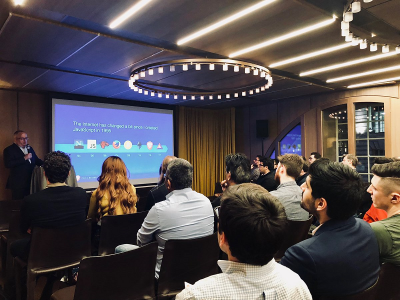Download the Brave Browser.
Basic Attention Token (BAT), co-created by the founder of Mozilla Firefox and Javascript, has been picking up momentum in its bid to remedy the problems of digital advertising. The BAT project is supplemented by the Brave browser, which lets users establish revenue relationships with their favorite content creators using Basic Attention Tokens.
For those unfamiliar with the project, BAT is seeking to make payment to content creators, such as those on YouTube, more fair. Currently, platforms like YouTube receive an enormous cut of the revenue and content creators receive a disproportionate amount of compensation for their work. The dangers of data aggregation and social manipulation through digital advertising are pain points that BAT would like to address. For a detailed look at the project, we recommend reading our guide to the Basic Attention Token.
This project has attracted the attention of several notable online creators, including YouTube celebrity Philip DeFranco, who has publicly voiced his support for the BAT project.
Late last week, they provided their community with a weekly report of their progress. Here, we’ll recap some of the highlights of that report, as well some of the major developments the project has made in recent months.
BAT’s Recent Developments
Following their ICO in the summer of 2017, the project has taken several steps to expand their ecosystem and the viability of BAT as a payment option.
Brave Paid Out $1 Million Worth of BAT to Content Creators
In January 2018, Brave distributed $1 million worth of BAT to anyone with the Brave desktop browser through a promotional option. The intention was to give people a certain amount of funds with which they could support their favorite content creators. This $1 million giveaway greatly eclipses their $50,000 giveaway in December 2017.
On March 24, 2018, Brave announced that they have paid out the allocated $1 million of BAT to over 50,000 website publishers and YouTube content creators.
Publishers and content creators can still register on the network and claim any free BAT that had been awarded to them. Currently, about 11,000 publishers have registered and Brave seeks to expand that number, encouraging content providers to sign up and claim their BAT rewards.
Brave Receives Apple’s Approval for Use in iOS Apps
Brave has officially received approval from Apple to act as a payment mechanism on the app store. This means that it can now act as a virtual currency/utility token without fear of repercussions. This was confirmed at a meetup in London, which we detail below. Currently, only the following coins have been approved for use as a virtual currency: Bitcoin, Bitcoin Cash, DogeCoin, Dao, Dash, Digicash, Americoin, Ethereum, Ethereum Classic, Litecoin, Lisk, Monero, Ripple, Steam, Tether, Waves, and ZCash.
BAT London Meetup

On March 22, the Brave and BAT team travelled to the headquarters in London for a meetup to discuss the future of the project. The major theme of the meetup was “How blockchain is revolutionizing digital advertising.” Other highlights from the event included a session on how to build a machine-learning ad agent and the implementation of the much talked about zk-SNARKs for private zones.
The team had planned another meetup in New York, but the session was cancelled due to bad weather. Expect more such meetups in the future.
Chrome and Firefox Receive Batify Extension, Allowing for Publisher Donations
Google Chrome and Firefox has received a new independent extension that tracks websites a user visits, then automatically routes anonymous monthly payments to content publishers and YouTubers. The amount donated is dependent upon the number of times the user visits the source and the amount of time spent on it. It is directly linked to Brave’s software system, thereby making sure that only registered publishers are paid.
Updated Desktop Client
Brave has made incremental improvements to their desktop clients, fixing some moderate bugs and making general adjustments.
What’s in Store for 2018?
Brave has put much of its effort so far into creating an environment where people are unburdened with irrelevant and bothersome advertisements, while also ensuring that content creators get their due. The first phase of their roadmap, “Mercury”, focused on making payments simpler, including improvements to the browser’s built-in wallet and easing the process of receiving payments for publishers. They also paid attention to increasing the user base, as evidenced by the giveaways.
The second phase of the roadmap, Gemini, continues to focus on developing the publisher pool while also developing the metric system on which revenue and ad targeting will be modelled. They are rewarding publishers with BAT through a referral program that pays publishers $5 worth of BAT for every new publisher they bring to the browser.
Machine learning models are being developed to ensure users receive more relevant advertisements—a step that will not only please viewers, but also aid advertisers by possibly drawing in more purchases and clicks.
A significant part of the Gemini stage is a trial session where select advertisers will be able to showcase their ads to the 2 million or so Brave users. This will be a stage where Brave can test the reaction of the users to their advertising system, and tweak out any errors or flaws that might exist in their targeting.
There is a lot on the table for BAT in 2018. If you’d like a closer look at the roadmap, read our guide to BAT’s 2018 roadmap. For a complete list of this week’s developments, look at their Reddit thread.
Download the Brave Browser.

